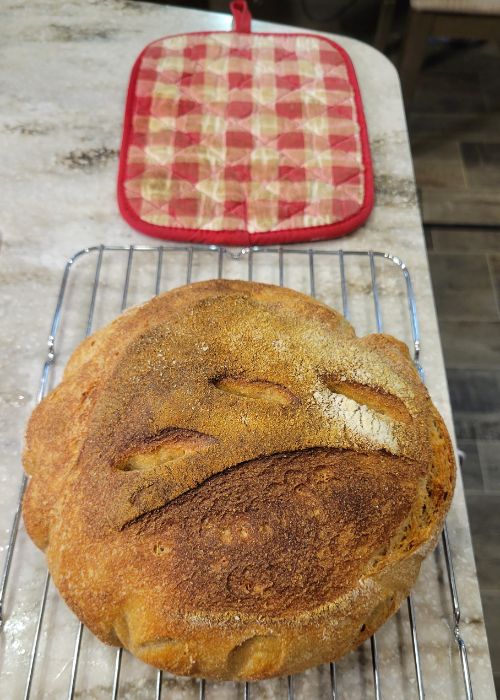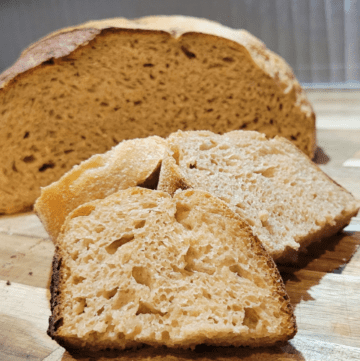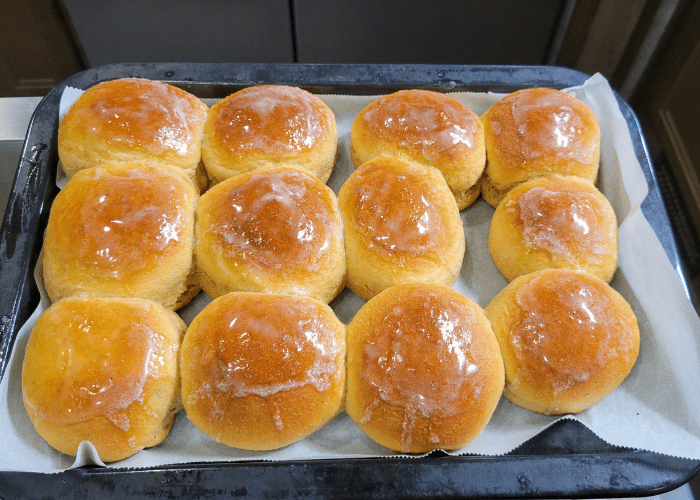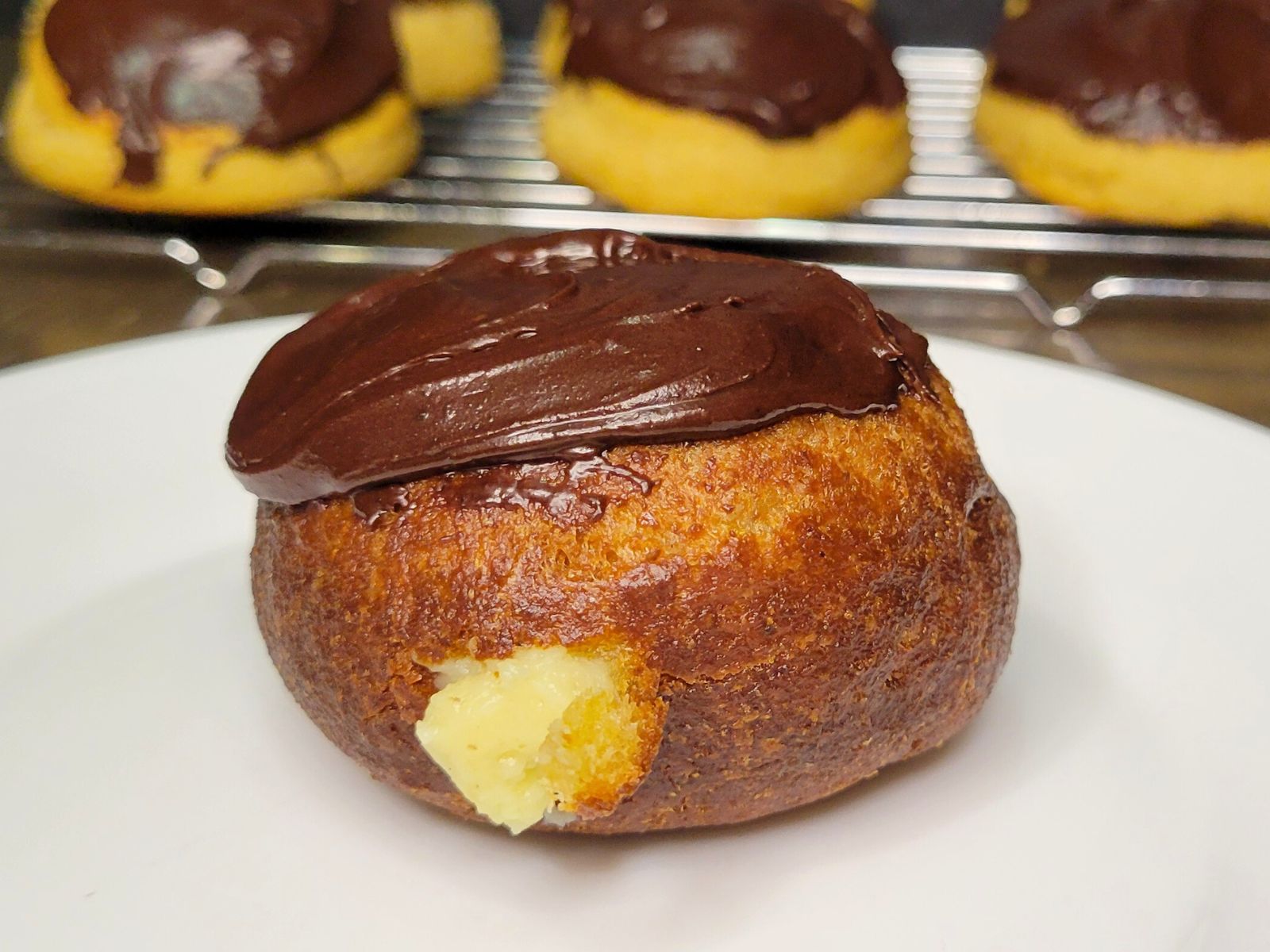Sourdough Bread With Fresh Milled Flour Made EASY
Sourdough Bread With Fresh Milled Flour Made EASY! If I can do it, you can do it. It is ok to fail, as long as you try again!

Ok, I had to do it! I am by no means a professional sourdough baker. I am assuming you have also seen those beautiful crusty sourdough loaves that are scored so perfectly that look like a piece of art that should be in an art gallery! Yes, I have seen those too, and they are gorgeous!
Beginner Sourdough Bakers
But, What About the Rest Of Us?
Right? The rest of us home bakers that just want to put healthy food on the table, and don’t have years to perfect a loaf before we can serve it to our family. I hear you! I am one of you! So, I decided to share my recipe.

You can see where the sourdough loaf decided it wanted to rise more, even where I did not have it scored. I love when a loaf comes alive and makes it’s own decisions, even if this may be considered a flaw to some. Each Sourdough bread loaf is different, and they all have their own character!
My Sourdough Journey
In the beginning, I had a beautiful sourdough journey, But, it did start out with 100% commercial white flour. I was lucky to take a class several years ago back in 2017. And, I soaked in all the info I could! The teacher also shared some of her over 100 year old Authentic San Francisco sourdough starter. I was so grateful for this amazing free gift! I cherished it and cared for it for many years.
How I Killed My Original Sourdough Starter
Then…. I killed it. sad day. That is the day I learned that bleached flour can kill your sourdough starter. I tried to no avail to revive him. But, in the long run, it was ok. Because, this forced me to make my own starter from scratch. Which I did, and did again, and did again. Sigh… You know what I mean right? I tried and failed, tried and failed again, and finally success! It is frustrating to mess up so many times, but WOW the satisfaction you feel when it finally works out, and is bubbly and YOURS!
My Sourdough Starter Made With Fresh Milled Flour
Eventually, I had a 100% fresh milled flour sourdough starter, made from scratch, by me! And, you know what? I take so much better care of something that I put so much time and effort on! “Bubbles,” my sourdough starter, is kind of like a pet in our house. He comes out on the counter and makes delicious food for us, then he gets to go on “vacation” in the fridge for a week or so if we have travel days, or a busy schedule, and I know he will get neglected.

Here is Bubbles, my sourdough starter. He is made with 100% Freshly Milled Flour. I use a mix of different whole wheat flours. Whichever wheat berry I use that day is typically what Bubbles gets fed.
Struggling With Fresh Milled Flour Sourdough
I struggled with making a good sourdough loaf once I switched to fresh milled flour. It was very frustrating to me, and I felt like I was wasting so much! Either the loaf was too dense, or way too sour, just completely inedible. I almost gave up! And, I put my sourdough starter, Bubbles in “time out” in my refrigerator for awhile. Oh, I wanted to just cry! How could I have the most beautiful loaves of sourdough bread with regular flour, but not with fresh milled flour.
Don’t Give Up On Sourdough, Try & Learn Until You Succeed!
But, if you know me at all, you know I just could not give up! Every time I opened my fridge, there was “Bubbles” just looking at me, almost begging to give him another try. Well, I am so glad my determination paid off, and I had to give it another try.
Each time I had a failed loaf, I learned something. Actually, I am still learning things. Every time I bake bread, any kind of bread, I learn!

Tricks To Sourdough Bread With Fresh Milled Flour Making It Easy
There are a couple tricks to know when working with fresh milled flour to make Sourdough Bread. I can tell you there are 2 major things I noticed, and once I switched things up, I started having success! Are my sourdough loaves perfect? No, Are they delicious, and nutritious? YES!
The first thing I realized is that Fresh milled flour (the hard wheat varieties) are so much thirstier! I used to make 75% hydration loaves with white flour with no issues. I found that fresh milled flour needs to be at a minimum 80% hydration. Don’t worry, I will cover what the heck hydration level is, and what I am talking about next.
The second important thing I realized was that fresh milled flour seems to ferment much quicker. So, I realized that overnight fermentation that I always did with white flour sourdough wasn’t working with fresh milled flour, it was ending up WAY to sour, and that is coming from family members who love a sour bread. (Not me, I prefer a mild sourness.)

This day I was using Spelt. These everyday Grain Storage Bins are Amazing to have on hand! They completely seal for freshness and keep out moisture, and they have a nice wide opening so I can get a large measuring scoop in and out easily. You can grab some HERE
What Is Hydration Level In Sourdough Bread?
Hydration level is the moisture level in the bread dough. Ok, great… what does that mean?
The hydration level in Sourdough Bread (or any bread, really, just more commonly talked about with sourdough) is always based on the weight of the flour, generally in grams. So, for example, if I start with 1000 grams of flour, and I use 800 grams of water, then the bread is 80% hydration. I hope that example makes sense.
Bakers Percentage Made Easy
So, to elaborate more on the hydration level, this also ties into bakers percentages. This will also come up when adding salt. So, let’s take that same 1000 grams of flour, and add 800 grams of water, and 20 grams of salt. These numbers may change with different recipes, but the precents will always go off the weight of the flour. So, with our example loaf, we have 80% hydration, and 2% salt. (this ratio will actually give you 2 nice loafs.)
Why Do I Need To Weigh The Ingredients To Make Sourdough?
Ok, this one can be super controversial (well, sourdough in general seems to be a bit controversial, lol – This is why it took me this long to make a sourdough loaf post, it takes bravery to write a post on sourdough, lol)
Do you need to weigh the ingredients to make sourdough? The answer is yes, and no! How can it be both? Well, if you want a truly successful loaf, that has correct ratios, and the proper procedure, yes. BUT, can you do without measuring in a pinch, sure. (Please sourdough experts, don’t kill me here! lol) I understand not every baker wants to weigh, and was taught to bake exclusively by volume (i.e. cups, etc.) So, for you guys, my recipe has weight and volume.
Measuring your ingredients by weight is still recommended and will give you better results with more accuracy. When measuring by volume, the amounts can vary based on density of flour and how much each persons flour is fluffed, etc.

I try to keep it simple, but when baking, a small kitchen scale gives me more accuracy.
Kitchen Scale
The great thing is kitchen scales are fairly cheap, and you may find yourself happy to have it for other kitchen projects as well. HERE is a link to a fairly inexpensive kitchen scale like the one I have. I have found many uses for mine over the years!
Ingredients For Sourdough Bread Made With Fresh Milled Flour – Easy
- 1 TBSP Sourdough Starter (15-20g) (Active, healthy, and bubbly)
- 550 g of Fresh Milled Hard White Wheat Flour – Divided (I mill by weight, but it should be about 3 cups of wheat berries milled into about 4&2/3 cups of total milled flour)
- 10 g sea salt (1&3/4tsp)
- 475 g room temperature filtered water – Divided (about 2 cups)
- Dusting of rice flour

Instructions For Easy Sourdough Bread Made With Fresh Milled Flour
I will try to explain this process in the best way possible. It may sound intimidating, but the process is not really as difficult as it may sound. I will put the volume and weight, but I HIGHLY suggest you use a scale and make this by weight! This recipe makes 4 Bread Bowls.
MAKE THE LEAVEN THE NIGHT BEFORE
- To make the leaven the night before, you use 1 TBSP of a hungry starter and mix it with 50g water(1/4cup) and 50g fresh milled hard white wheat flour (1/2cup). Mix to combine, and let sit covered at room temperature overnight.
THE NEXT MORNING
- Firstly, pour 400g of room temperature filtered water into a medium bowl.
- Then, add the leaven you made the night before. (the leaven should appear to lightly float if it is ready) Stir.
- Next, add 500 g of fresh milled hard white wheat flour, mix until no dry flour is left. Cover and let sit for 30- 45 minutes. This is called the Autolyse.
- In a separate small bowl, add 25g room temperature filtered water(1/8cup) and 10g of sea salt(1&3/4 tsp), stir to start dissolving the salt.
- Then, after it had a chance to absorb the water, now add the salt & water mixture. and mix it in with your hands. You should see that the dough already is softer and not so shaggy. Cover, and let sit for 30-60 minutes. This is the beginning of the Bulk Ferment.
- Pull & fold dough in the bowl, turning the bowl a few times, Then cover.
- Repeat this Pull & Fold technique every 30-60 minutes until the dough rises about 20-30%. It should get bubbly, and stretchy over time. This phase should take about 4-6 hours.
Shaping The Loaf
- Then, take it to a clean flat work surface, start to shape the loaf. Use the cup & turn technique to form a round shape.
- Let the dough ball rest for 10-20 minutes. This is called the Bench Rest.
- Repeat shaping 1-2 more times, until the dough ball forms good surface tension. You should notice the dough ball “remembers” better each time you shape it.
- During this time, preheat oven to 480*F with Dutch Oven or a High Heat Proof Baking Vessel With Lid inside. (If you don’t have one, never fear, check the notes for an alternative.)
- Place dough on parchment paper, and coat dough ball with a little rice flour and score the loaf however you desire.
- Place loaf in preheated Dutch oven with lid on.
- Bake bread 30 minutes at the 480*F covered.
- Then, decrease oven to 450*F, remove the lid, and continue baking 20-25 more minutes.
- Check the temperature of the loaf, and bake until the internal temperature of the loaf reaches. 210*F
- Let the loaf cool completely before slicing into it.
What If I Don’t Have A Dutch Oven?
You don’t HAVE to have a Dutch oven to make Sourdough. It does make your loaf a little better, but I have an alternative method that won’t require you to purchase anything new… yet.
Alternate Sourdough Cooking Method Without A Dutch Oven
If you don’t have a Dutch Oven, the alternative method would be to use a heat save bowl, fill it with water, and preheat the oven with that water inside to create steam. Then, place loaf on parchment paper and on a baking sheet, and bake with the water in the oven for the first 20 minutes.

I also LOVE To make Sourdough bread bowls, you can find that recipe HERE
What If I Already Have A Sourdough Starter, But It Is Not Fresh Milled Flour?
Well, I have a whole post on how to transform your sourdough starter into 100% Fresh Milled Flour. HERE is that post. I also have a ton of sourdough Discard Recipes you can find HERE

Make Your Own Sourdough Starter From Scratch With Fresh Milled Flour
If you don’t already have a sourdough starter, but are wanting to make one with 100% fresh milled flour from scratch, I am here for you! I have a video resource that goes over how you can make your very own sourdough starter using only freshly milled flour. I also go over troubleshooting issues to help make this process a little easier for you, and I make a brand new sourdough starter right along side you! You can watch that video HERE.
I also have a written blog post that covers this information, if you would like to print it out and have it handy for when you are just getting started. You can do this, it is not as difficult as some on the internet have made it seem! You can checkout my blog post about it HERE.
Simple Way To Level Up Your Sourdough Bread
I have a great dipping oil recipe that tastes amazing with this sourdough bread. I make it with dried herbs and seasonings if that is what I have on hand, but I love to make it with fresh herbs whenever I have access to them. HERE is that recipe.

Shop This Post
Sourdough Whole Grain Recipe Book
Check Out Some Of My Other Recipes
Sourdough Chocolate Peppermint Cupcakes
Chocolate Sourdough Swiss Cake Roll
Pumpkin Roll From Sourdough Discard
Interested In Learning More About Milling Flour At Home?
I have a great beginner post HERE about Fresh Milled Flour : 101. It is a great place to start. I also have a whole video on Fresh Milled Flour 101 – Learn to mill flour at home video – HERE
More Fresh Milled Flour Recipes
Fresh Milled Flour Recipe list
Sourdough Fresh Milled Flour Made EASY Video
This video is showing the process I use for sourdough bread, I am making smaller bread loafs for bread bowls here, however, the recipe and technique remain the same until it comes time to divide the loaf.
Sourdough Bread Made Easy With 100% Fresh Milled Flour Printable Recipe

Sourdough Bread Made With Fresh Milled Flour
Ingredients
- 1 TBSP Sourdough Starter (15-20g) Active, healthy, and bubbly
- 550 g Fresh Milled Hard White Wheat Flour – Divided I mill by weight, but it should be about 3 cups of wheat berries milled into about 4&2/3 cups of total milled flour
- 10 g sea salt 1&3/4tsp
- 475 g room temperature filtered water – Divided about 2 cups
- Dusting of rice flour
Instructions
Note About Weight VS Volume Measuring
- I will try to explain this process in the best way possible. It may sound intimidating, but the process is not really as difficult as it may sound. I will put the volume and weight, but I HIGHLY suggest you use a scale and make this by weight! This recipe makes 1 Sourdough Bread Loaf
MAKE THE LEAVEN THE NIGHT BEFORE
- To make the leaven the night before, you use 1 TBSP of a hungry starter and mix it with 50g water(1/4cup) and 50g fresh milled hard white wheat flour (1/2cup). Mix to combine, and let sit covered at room temperature overnight.
The Next Morning
- Firstly, pour 400g of room temperature filtered water into a medium bowl.
- Then, add the leaven you made the night before. (the leaven should appear to lightly float if it is ready) Stir.
- Next, add 500 g of fresh milled hard white wheat flour, mix until no dry flour is left. Cover and let sit for 30- 45 minutes. This is called the Autolyse.
- In a separate small bowl, add 25g room temperature filtered water(1/8cup) and 10g of sea salt(1&3/4 tsp), stir to start dissolving the salt.
- Then, after it had a chance to absorb the water, now add the salt & water mixture. and mix it in with your hands. You should see that the dough already is softer and not so shaggy. Cover, and let sit for 30-60 minutes. This is the beginning of the Bulk Ferment.
- Pull & fold dough in the bowl, turning the bowl a few times, Then cover.
- Repeat this Pull & Fold technique every 30-60 minutes until the dough rises about 20-30%. It should get bubbly, and stretchy over time. This phase should take about 4-6 hours.
Shaping & Baking The Loaf
- Then, take it to a clean flat work surface, start to shape the loaf. Use the cup & turn technique to form a round shape.
- Let the dough ball rest for 10-20 minutes. This is called the Bench Rest.
- Repeat shaping 1-2 more times, until the dough ball forms good surface tension. You should notice the dough ball “remembers” better each time you shape it.
- During this time, preheat oven to 480*F with Dutch Oven or a High Heat Proof Baking Vessel With Lid inside. (If you don't have one, never fear, check the notes for an alternative.)
- Place dough on parchment paper, and coat dough ball with a little rice flour and score the loaf however you desire.
- Place loaf in preheated Dutch oven with lid on.
- Bake bread 30 minutes at the 480*F covered.
- Then, decrease oven to 450*F, remove the lid, and continue baking 20-25 more minutes.
- Check the temperature of the loaf, and bake until the internal temperature of the loaf reaches. 210*F
- Let the loaf cool completely before slicing into it.
Video
Notes
*This post contains affiliate links, which means I make a small commission at no extra cost to you! As an Amazon Associate I earn from qualifying purchases. But I will only suggest items I actually Love and Have Used!








Hi, Kara–Was really interested to try this and followed along using the recipe from your book (easier to read than the computer!). Everything was fantastic until I got to the shaping and the dough started getting more damp and losing its shape. When I would shape it again it was fine but as soon as I stopped it would expand out. It was difficult to score since it was so damp. I have had a problem since moving to all FMF in that my doughs often are very wet (this one was just damp). The dough temp was in the low 70’s and the humidity in the room was in the mid 40’s. Any ideas? The bread was still good, just not very high. I followed your directions on timing and ingredients exactly. Help! I really want to stick with 100% FMF! Thanks!
It could be that it was starting to over proof, so it wouldn’t hold it’s shape. OR just that it needed more surface tension. OR that you may need a tad bit less water. But, if it was good texture all the way until shaping, I would guess it was starting to overproof. Try shortening the ferment time next time, and see if that helps. Let me know how it goes! 🙂
Hi, I tried making this starter , and it formed liquid in bubbles throughout the starter, not just on top. It never rose, anyways not that I noticed. My milled flour is not as fine as regular flour, so I’m wondering if that could be the issue? Would you have any advice for me?
It could be that the flour is too coarse, what mill do you have? If it’s too coarse it won’t be able to form a stretch to hold itself up.
I just got a Mockmill and the first time I used it the flour came out a bit course. After going over the manual, I realized it had to be adjusted because the stones weren’t touching on the finest setting.
Just made my first FMF sourdough loaf. It came out great!! Thanks for the recipe and great tips!
Awesome! I am happy to hear it was a hit! Nice job! Thanks 🙂
Hi – I’m in Costa Rica so very humid – any idea how much extra flour to use when making in a humid climate? You mentioned using more and in general I do seem to have to use more flour but with the combination of switching to FMF and a humid climate not sure how much to adjust. Thank you!
I actually recommend using less water rather than more flour, I talk about how to adjust for wet dough in this video if interested. I hope that helps! https://youtu.be/tdnCrbOsVag
Hi! I have read that cold proofing for three days is ideal. Can I do this with this recipe?
I don’t recommend a long cold proof with fresh milled flour, because it tends to ferment so much faster. Even an overnight ferment tends to over proof the dough.
Hi! Just to clarify – should I feed the whole starter, maybe the first morning, then use 1 TBSP of that at night to make the Levain? I thought “hungry” meant unfed, but looking at the timeline of 2+days I thought maybe that included a first feeding? And I don’t have to use a starter that uses freshly milled flour, do I?
I actually have an updated sourdough bread recipe that is a little easier to understand. 😉 I really like this one. https://grainsinsmallplaces.net/fresh-milled-flour-sourdough-bread/
Let me know how it goes if you give it a try. 🙂
I have made this twice and it is delicious. I follow the recipe by weight, but by the shaping stage my dough won’t hold its shape very well and the dough round sags. Do you have any suggestions on how to make the dough hold it’s shape?
You can shape it tightly, then let it rest and shape again. Sometimes a second or third shaping will help the dough to “remember.” OR it is possible it is starting to loose it’s ability to hold up the dough if it is getting close to over proofing. You can try shortening the rise time and see if that fixes it. Fresh milled flour ferments at a much quicker rate than white flour with sourdough.
I switched to fresh milled flour 8 months ago and have struggled to find a recipe that works, until now! This one has helped with all of the issues with my past loaves. Thank you so much for the clear and detailed instructions!! My family and I love this bread!
Awesome! I am so happy to hear that! Thank you so much! 🙂
Grinding my grains with a Mockmill. (Love that thing) Only had 500 grams of hard white left so I used some spelt grain for the rest. I also used the suggestion from your other recipe and tossed in 2 tablespoons of vital wheat gluten. Loaf looks fabulous, just waiting for it to cool down. Thanks for the recipe.
Yay! So glad to hear it was a hit! Nice job! Thanks so much 🙂
Hi Kara! I’ve been making sourdough bread for a couple of years now with commercial flour, but I want to start with FMF, Just wondering if I could knead the dough in the stand mixer after autolyse, unfortunately I have shoulder issues and that might not be possible at this point. Thanks for your recipes
Hi! Yes, you can knead in the stand mixer to develop the gluten and skip the stretch and folds. Just knead until nice and stretchy after the autolyse period.
I’m about 10 years into my journey making natural levain breads. In that time I freshly milled my flour but sifted it. Over this past year I have been baking everyday with unsifted, freshly milled flour, here are some things to think about:
If you are first starting out on this journey don’t use hard red wheat, use hard white wheat, its has a milder flavor and the bran is not as hard. Rouge de Bordeaux flour has an amazing flavor and has an even softer bran but I have noticed that even though its considered a hard wheat it can act like a soft wheat.
Start with hydration levels in the zone of 80-90%. Hard white wheat that I recently purchased from Central Milling at a 80% hydration level had a dough feel that felt like what a 65-70% all sifted white flour dough felt like. It would be a good place to start with things like baguette, pizza dough, bagels, or a dough that is easier to handle. Even at 90% hydration level, this hard white wheat wasn’t that hard to work with and actually had better extensibility.
I would also suggest getting your starter on a 12 hour feeding schedule and start making a stiffer starter, they are much nicer to work with especially with 100% unsifted flour.
If you don’t plan to bake everyday then I personally wouldn’t use natural levain as a leavener for my dough, I would stick with commercial yeast in smaller quantities, say for 500 grams of flour use 1-2 grams yeast.
Start treating your starter like its your main dough, autolyse for an hour then give it a stretch and fold. Yeast love oxygen.
Also, a true autolyse is only when you mix flour and water.
Bulk fermentation starts when you add your stater or yeast.
Bulk fermentation depends on these variables: how active your starter is, dough temperature/environment temperature, how much stater was added.
If your internal dough temperature is between 78-80F during bulk then your looking for about a 30% rise in your dough during bulk fermentation. Remember the dough is still fermenting even after shaping and even when you put it to cold retard in the fridge.
I’ve noticed that when my kitchen temperature is between 78-80F then the dough temperature is roughly that as well. So this could mean that my dough has a 30% rise in 5.5-6 hours. Oddly enough I do not see that my unsifted flour loaf “rise” or gets done with bulk fermentation any faster just because it has been unsifted.
I would also suggest adding the salt to the dough 30 minutes after your add the levain.
If your dough is ripping and tearing while you stretch and fold you are either pulling too hard or haven’t allowed the dough enough time to relax between stretch and folds. Or possibly hydration level too low.
Thanks for sharing!
This was the best tasting sourdough I’ve tasted with FMF! I made it with Spelt berries. It was too runny to hold it’s shape, so was a little flat. I just read that different berries weigh different amounts. For example, 1 cup of hard red or white weighs amoximently 130g while Spelt weighs 105g. I will try to adjust for this next time.
I am happy to hear it was delicious! Spelt alone doesn’t have a strong enough gluten to hold the loaf up, so it will be a flatter loaf. To get a taller strong loaf, you will want to use mostly a hard wheat. OR add vital wheat gluten.
I made this recipe yesterday and it turned out so good! The only thing is I would add a little more salt. I used only 10 g . I thought my dough was too wet and I was worried but it rose beautifully and my husband really liked it. It was my first ever sourdough bread with freshly milled flour and I will definitely make it again. I have a question… in this recipe you say to add the salt after the autolyse period. You have another very similar easy sourdough bread recipe, and there you add the salt in right away. Is there a difference between the outcome from the 2 different recipes?
I have done it both ways, and don’t notice a huge difference. This is a great base recipe you can tweak to your liking. 🙂
I haven’t tried the recipe. There are so many ads on the page that it keeps shutting my browser down before I can fully get the recipe. Disappointed.
Sorry to hear that. I try to keep a balance on there, I want to be able to let everyone access my recipes without paying for them or requiring an email, just so anyone who wants to use them can. I do have a cookbook available as well with my most popular recipes in it. However, my newer recipes that I have put out since it was published are not in there. My Cook Book: https://amzn.to/3O8ZL4p
Hardback: https://amzn.to/3Ck3v0b #ad